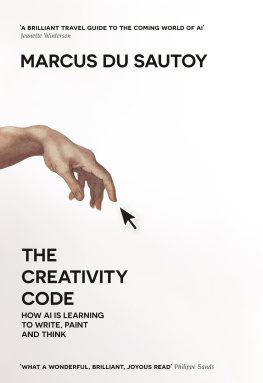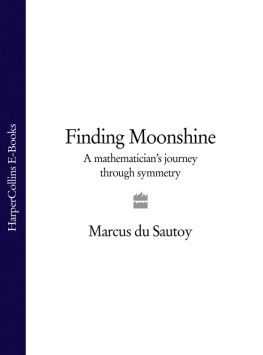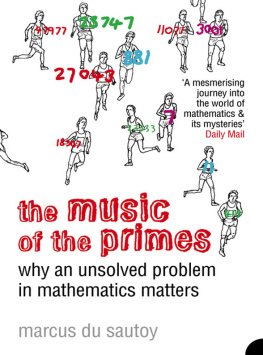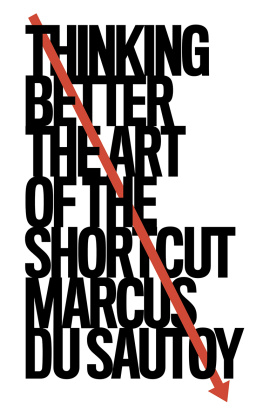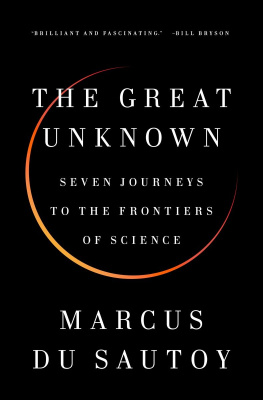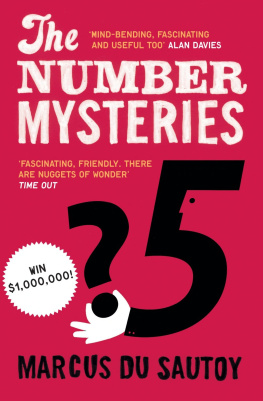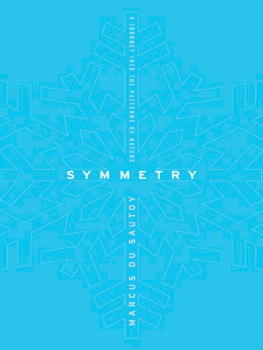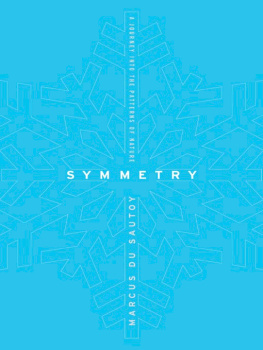THE NUMBER MYSTERIES
THE NUMBER MYSTERIES
A Mathematical Odyssey through Everyday Life
MARCUS DU SAUTOY


THE NUMBER MYSTERIES
Copyright Marcus du Sautoy, 2011.
All rights reserved.
First published in 2010 by Fourth Estate, an imprint of HarperCollins UK First Published in the United States in 2011 by
PALGRAVE MACMILLANa division of St. Martins Press LLC, 175
Fifth Avenue, New York, NY 10010.
Palgrave Macmillan is the global academic imprint of the above companies and has companies and representatives throughout the world.
Palgrave and Macmillan are registered trademarks in the United States, the United Kingdom, Europe and other countries.
ISBN 978-0-230-11384-8
Library of Congress Cataloging-in-Publication Data
Du Sautoy, Marcus.
The number mysteries : a mathematical odyssey through everyday life / Marcus du Sautoy.
p. cm.
Includes index.
ISBN 978-0-230-11384-8 (pbk.)
1. MathematicsMiscellanea. I. Title.
QA99.D8 2011
510dc22
2011000535
A catalogue record of the book is available from the British Library.
Design by Letra Libre, Inc.
First Palgrave Macmillan edition: May 2011
10 9 8 7 6 5 4 3 2 1
Printed in the United States of America.

CONTENTS

A NOTE ON WEBSITES
There are references throughout the book to external websites. All of these sites can be accessed in the usual way, by typing the address into a web browser. Alternatively, if you have a smartphone, you can use it to scan the QR codes printed by each website. QR codes are two-dimensional grids of black and white pixels and act like a bar code. On a QR codecompatible smartphone, you will need to download a QR reader first. To scan the code, launch the reader and hold the camera lens over the bar code in a sufficient amount of light. Most Android smartphones come with a built-in facility to scan QR codes. Those who own an iPhone can download a free QR reader from the App Store. Just enter the words QR reader into the search box. Blackberry phones running Blackberry Messenger 5.0 (or more recent versions) can also scan QR codes using the Scan a Group Barcode option in the Blackberry Messenger menu. A QR reader wont just be useful for enhancing your reading of the book. Originating in Japan, QR codes are being used increasingly across the globe on posters, as boarding passes for flights, and even on T-shirts to facilitate arranging a date with the person wearing the T-shirt.

INTRODUCTION
Is climate change a reality? Will the solar system suddenly fly apart? Is it safe to send your credit card number over the Internet? How can I beat the casino?
Ever since weve been able to communicate, weve been asking questions, trying to make predictions about what the future holds, and negotiating the environment around us. The most powerful tool that humans have created to navigate the wild and complex world we live in is mathematics.
From predicting the trajectory of a football to charting the population of lemmings, from cracking codes to winning at Monopoly, mathematics has provided the secret language to unlock natures mysteries. But mathematicians dont have all the answers. There are many deep and fundamental questions we are still struggling to answer.
In each chapter of The Number Mysteries, I will take you on a journey through the big themes of mathematics, and at the end of each chapter, I reveal a mathematical mystery that no one has yet been able to solve. These are some of the great unsolved problems of all time.
But solving one of these conundrums wont just bring you mathematical fameit will also bring you an astronomical fortune. An American businessman, Landon Clay, has offered a prize of a million dollars for the solution to each of these mathematical mysteries. You might think it strange that a businessman should want to hand out such big prizes for solving mathematical puzzles. But he knows that the whole of science, technology, the economy, and even the future of our planet relies on mathematics.
Each of the five chapters of this book introduces you to one of these million-dollar puzzles.
, The Curious Incident of the Never-Ending Primes, takes as its theme the most basic object of mathematics: numbers. I will introduce you to the primesthe most important numbers in mathematics but also the most enigmatic. A mathematical million awaits the person who can unravel their secrets.
In , The Story of the Elusive Shape, we take a journey through the worlds weird and wonderful shapes: from dice to bubbles, from tea bags to snowflakes. Ultimately, we tackle the biggest challenge of them allwhat shape is our universe?
, The Secret of the Winning Streak, will show you how the mathematics of logic and probability can give you the edge when it comes to playing games. Whether you like playing with Monopoly money or gambling with real cash, mathematics is often the secret to coming out on top. But there are some simple games that still fox even the greatest minds.
Cryptography is the subject of , The Case of the Uncrackable Code. Mathematics has often been the key to unscrambling secret messages. But I will reveal how you can use clever mathematics to create new codes that let you communicate securely across the Internet, send messages through space, and even read your friends mind.
is about what we would all love to be able to do: The Quest to Predict the Future. I will explain how the equations of mathematics are the best fortune-tellers. They predict eclipses, explain why boomerangs come back, and ultimately tell us what the future holds for our planet. But some of these equations we still cant solve. The chapter ends with the problem of turbulence, which affects everything from David Beckhams free kicks to the flight of an airplane, yet is still one of mathematics greatest mysteries.
The mathematics I present ranges from the easy to the difficult. The unsolved problems that conclude each chapter are so difficult that no one knows how to solve them. But I am a great believer in exposing people to the big ideas of mathematics. We get excited about literature when we encounter Shakespeare or Steinbeck. Music comes alive the first time we hear Mozart or Miles Davis. Playing Mozart yourself is tough, and Shakespeare can often be challenging, even for the experienced reader. But that doesnt mean that we should reserve the work of these great thinkers for the cognoscenti. Mathematics is just the same. So if some of the mathematics feels tough, enjoy what you can and remember the feeling of reading Shakespeare for the first time.
At school, we are taught that mathematics is fundamental to everything we do. In these five chapters, I want to bring mathematics to life to show you some of the great mathematics we have discovered to date. But I also want to give you the chance to test yourself against the biggest brains in history, as we look at some of the problems that remain unsolved. By the end, I hope you will understand that mathematics really is at the heart of all that we see and do.
Next page


